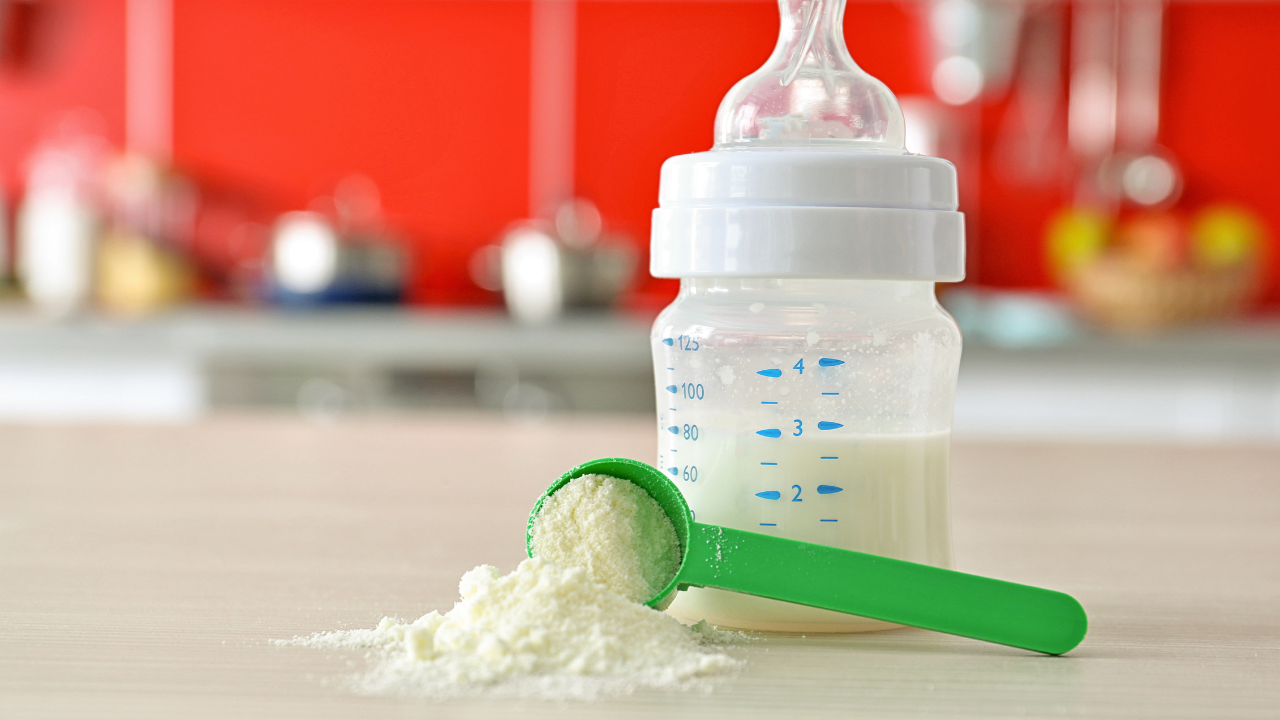
Storing. Wondering how to safely use and store formula? Start by preparing formula using safe water, following directions on the container. Toss any bottles your baby doesn’t finish within an hour and any bottles that sit out for more than two hours – and don’t reheat formula that has been warmed before. You can prepare a day’s worth of bottles in advance and store them in the fridge for up to 24 hours. To avoid dangerous bacterial illnesses, don’t use formula that has expired or been recalled for storing.
IN THIS ARTICLE
- How to prepare baby formula
- How long can formula sit out?
- How long is formula good after it’s mixed?
- How long is formula good in the fridge?
- Can you reheat formula?
- If your baby didn’t finish a bottle, can you reuse it?
- Traveling with formula
- More tips on using and storing formula safely
- Protecting your baby from bacteria in formula
Safely preparing and storing formula can protect your baby from the risks of food poisoning and bacterial illness. Follow these guidelines for preparing bottles, storing formula, and using pre-made bottles.
How to prepare baby formula
First, clean the area where you’ll be making bottles. Wash your hands well and dry them on a clean towel or paper towel.
Make sure the bottles you’re using are cleaned thoroughly (run them through the dishwasher or hand wash in hot, soapy water). If you’re using them for the first time, sterilize your bottles and bottle parts by boiling them in water for 5 minutes, using a microwave steam sterilizer bag, or using an electric steam sterilizer.
If you’re using ready-to-feed (premixed) formula, you don’t need to add any water. If you’re using powdered or liquid concentrate formula, follow the directions on the container to see how much formula and water to use.
Use safe water for preparing formula – if you’re not sure about the safety of your tap water, use bottled water or boil your water. To boil water for formula, bring cold tap water to a rolling boil for one minute only, then cool the water to room temperature for no more than 30 minutes before making bottles.
To make a bottle, always add the water first, then the formula. Attach the nipple and cap to the bottle and shake it well. If you’re preparing a larger batch of formula for the day, pour it into individual bottles and put them in the back of your fridge, where it’s coldest.
How long can formula sit out?
If you leave formula sitting outside of the fridge, be sure to use it within two hours. Room temperature is the perfect climate for bacteria to grow, so you’ll need to throw away a bottle that has been sitting out for two hours or longer.
If your baby starts a bottle but doesn’t finish it within an hour, throw the leftover formula away. Bacteria from your baby’s mouth can seep into the bottle, contaminate the formula, and make your baby sick if they drink it later.
Also, if you’ve warmed a bottle, you’ll need to feed it to your baby within one hour or throw it out. Don’t put warmed formula back in the fridge to use later.
Concerned about preparing your infant’s formula properly and safely? Learn about the three kinds of formula and the safest way to prepare them at or away from home.
How long is formula good after it’s mixed?
Once you’ve mixed powdered or liquid concentrate formula with water, it’s best to use it or refrigerate it immediately.
If you’re refrigerating your formula, you can put it in closed bottles or a tightly covered container and store it in the fridge for up to a day. After 24 hours, toss any you haven’t used, because bacteria may have formed.
Once you’ve opened ready-to-feed formula, store it in closed bottles or tightly cover the container and refrigerate it immediately. Discard any that’s leftover based on the package directions. Most ready-to-feed formula is meant to be thrown away within 48 hours of opening.
Tip: Label bottles with the date and time you prepared them. Write on painter’s or masking tape, use a sticky note, write with a wax pencil, or set an alarm on your phone – whatever method is easiest for you(for storing).
How long is formula good in the fridge?
As long as your baby hasn’t started drinking from them, pre-mixed bottles of formula can last storing for 24 hours in the fridge.
An open container of ready-to-feed formula or concentrated formula will be good for 48 hours if refrigerated.
Based on how much formula your baby needs, mix only what you think you’ll use in 24 hours. To prevent waste and save time, you may want to make a large batch of formula in the morning or the night before and pour it into individual bottles that you can refrigerate and use throughout the day.
Tip: Place bottles toward the back of the refrigerator, not in door compartments, which don’t stay as cold. Put the newest bottles in the far back and rotate any older bottles to the front.
Can you reheat formula?
No. Once you’ve warmed a bottle of formula, it should be consumed within the hour. Reheating formula increases the chance of bacterial growth.
To warm a refrigerated bottle of formula safely, run it under very warm or hot water and gently swirl the liquid for a few minutes. Or, place the bottle in a bowl of very warm or hot water until it reaches the temperature your baby likes.
Another option is to use a bottle warmer that sits on your countertop (or plugs into your car’s lighter socket when you’re on the go.)
Never use a microwave to warm a bottle. These can heat the liquid unevenly, creating hot spots that could burn your baby’s mouth.
Before you feed a warmed bottle to your baby, check the temperature by squeezing a little on the inside of your wrist. Formula should feel warm, not hot.
Tip: While some babies prefer a warm bottle, there’s no medical reason to warm formula. So if your baby is fine with room-temperature or cold formula, you can skip heating it up.
If your baby didn’t finish a bottle, can you reuse it?
If your baby starts a bottle of formula but doesn’t finish it within an hour, toss it. Don’t refrigerate and reheat leftovers. Bacteria from your baby’s mouth can seep into the bottle, contaminate the formula, and make them sick.
Also, after leaving a bottle out at room temperature, make sure to clean the bottle carefully before you use it again.
Traveling with formula
When you’re out and about with your baby, how can you prepare and give them a bottle safely? Here are your options:
- Ready-to-feed formula: The easiest option is to carry an unopened container of ready-to-feed formula and a clean, empty bottle. When your baby is ready for a feeding, pour the formula into the bottle and serve it right away. However, ready-to-feed formula is more expensive, and your baby may not like it if it’s not what they usually drink.
- Powdered formula: Before you leave home, fill a bottle or bottles with clean water. Bring a small container of powdered formula and the scoop along with you, and mix the powered formula into the water when your baby is ready for a bottle. Shake it up and serve.
- Premade bottles: When bringing a premade bottle out with your baby, chill it for at least an hour in the back of the refrigerator. Use a soft cooler bag to keep the bottle(s) cold. If the cooler bag doesn’t keep bottles at 35 to 40 degrees, though, you’ll need to use them or refrigerate them within two hours.
More tips on using and storing formula safely
- Check the label on powdered formula containers to see how long the formula stays good after you open it. In most cases, manufacturers recommend disposing of formula if it hasn’t been used within 1 month of opening the container. You may want to write the date you opened the container on the lid.
- All formula, even unopened, should be thrown away after the use-by date on the container.
- Watering formula down to stretch it further isn’t safe for your baby. Formula-fed babies need all the nutrients and calories formula provides. Plus, too much water can make your baby sick, causing the electrolytes in their body to become imbalanced, which can result in seizures.
- Heat and cold can degrade the nutrients in formula, so keep unopened liquid and powdered formula in a cool place. The optimum storage temperature is between 55 and 75 degrees Fahrenheit, but make certain that it stays below 95 degrees and above freezing (32 degrees Fahrenheit).
- Store formula in a cabinet or on a shelf located away from your stove, oven, heating ducts, and hot water pipes. Don’t leave cans in direct sunlight or in a hot car, and don’t put them in the freezer.
- Don’t put powdered formula in the refrigerator or another damp place, because humidity can cause the powder to clump, which may over-concentrate the formula.
Protecting your baby from bacteria in formula
Cronobacter bacteria can contaminate powdered infant formula and make babies very sick. Though Cronobacter illnesses are rare, they are serious and can even cause death.
Contact your baby’s doctor immediately if you believe your baby was fed recalled formula or if you suspect they could have a Cronobacter infection. Symptoms include:
- Fever accompanied by poor feeding, excessive crying, or very low energy
- In some cases, seizures
To protect your baby from Cronobacter, the Centers for Disease Control and Prevention (CDC) advises parents and caregivers to take care when preparing and storing powdered formula.
If your baby is younger than 3 months old, was born prematurely, or has a weakened immune system, they’re especially vulnerable to Cronobacter. You may want to:
- Consider using ready-to-feed formula, which is sterile.
- Breastfeed your baby if you can.
- Prepare powdered formula with hot water (at least 158 F/70 C) to kill any germs. Boil water and let it cool for about five minutes before making a bottle. Refrigerate the bottle right away or cool it and give it to your baby.
Read more about


Add a Comment